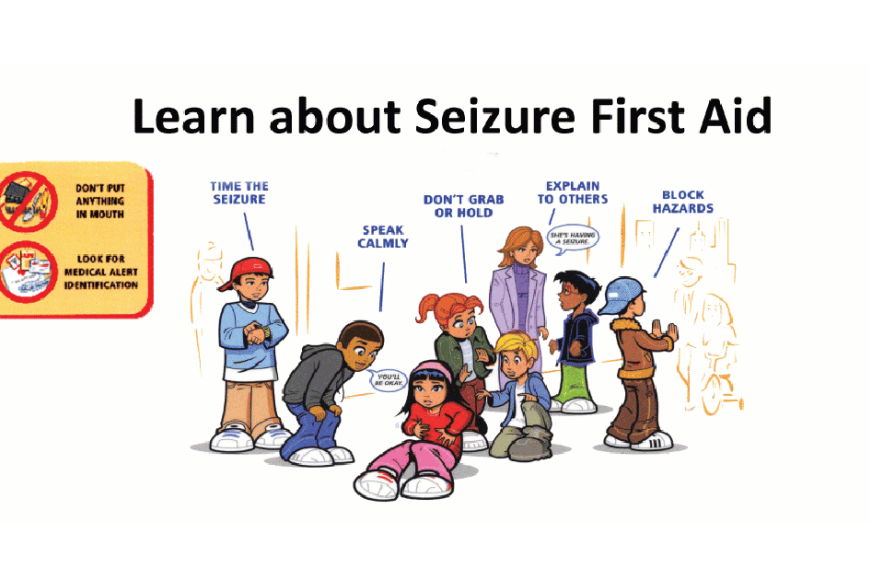Adapting First Aid Plans
Adapting First Aid Plans
What happens during a seizure may vary from one person to the next. Most of the time, following STAY- SAFE- SIDE are all that is needed. These steps can be tailored to what happens during the seizure and the setting where it occurs. For example, changes in a person's awareness or alertness and or physical movements during a seizure pose different safety risks. Also how to keep a person safe and respond to a seizure may vary in different settings, for example in water, on the street, or on public transportation.
This section suggests ways to help depending on a person's awareness. Other pages describe seizure first aid in relation to specific types of seizures. All the approaches focus on the 3 simple steps: STAY - SAFE - SIDE.
Seizures Without Any Change in Awareness
Some people may remain fully awake and alert during a seizure and remember everything that occurs. For example, awareness is not affected during simple partial or myoclonic seizures. During these types of seizures, pay particular attention to the following:
- Usually you don’t need to do anything.
- Stay calm and reassure the person they are safe.
- If the person is frightened or anxious, encourage them to take slow deep breaths or do something that is calming or relaxing.
- Stay with the person until the seizure is over. Make sure that they are fully aware of what is going on before they are left alone.
More first aid for focal aware (simple partial) seizures
Seizures with Altered Awareness
Sometimes people may look awake during a seizure, but they really are not aware of part or all of what is going on around them. They may not remember what happens during the seizure or have difficulty talking about it during or after it. The person may walk around during the seizure, but not be in control of where they are going, and they may not be able to protect themselves. These seizure behaviors may be seen with complex partial seizures or clusters of absence seizures. During these episodes, in addition to basic first aid, pay particular attention to the following:
- If the person has a warning before they lose awareness, help them to a safe place.
- Stay with the person and don’t let them wander away. Let them walk in an enclosed area if possible.
- Keep the person away from sharp objects or dangerous places.
- If the person tries to run or is in a dangerous situation, call for help and hold them back if needed to keep them out of danger.
- Do not assume that they can talk or that they can hear you and follow instructions. Assure them they are safe and repeat instructions on what they should do next.
- Make sure that they are alert, oriented and safe after the event before they are left alone.
- Time the seizure – these types of seizures are usually longer than convulsions or tonic clonic seizures. It may be hard to tell when the seizure ended and when the recovery period begins and ends.
- If the seizure turns into a convulsive seizure, follow first aid steps for tonic-clonic seizures.
More first aid for focal impaired awareness (complex partial) seizures, absence seizures and atonic and tonic seizures
Seizures with Loss of Consciousness
Some types of seizures can affect a person’s awareness completely – they may be considered ‘unconscious’. They are not able to talk, are not aware of what is going on around them, and may not realize what occurred afterwards. If they have a warning at the start of the seizure, they may be able to get to a safe place – otherwise they are at risk for injury during and after the seizure. Follow the steps for care and comfort first aid with attention to the following:
- Watch how long the seizure lasts – call for emergency medical help if a generalized seizure lasts 5 minutes or longer.
- Protect the person from injury but don’t restrain their movements.
- Watch their breathing – turn them on the side to help keep the airway open. If breathing problems occur, call 911.
- Don’t put any objects in their mouth.
- Know when to call for emergency help.
- Stay with the person after the seizure until they are aware and safe.
More first aid for tonic-clonic seizures
First Aid in Special Conditions
Learn about Types of Seizures
Resources
Epilepsy Centers
Epilepsy centers provide you with a team of specialists to help you diagnose your epilepsy and explore treatment options.
Epilepsy Medication
Find in-depth information on anti-seizure medications so you know what to ask your doctor.
Epilepsy and Seizures 24/7 Helpline
Call our Epilepsy and Seizures 24/7 Helpline and talk with an epilepsy information specialist or submit a question online.
Tools & Resources
Get information, tips, and more to help you manage your epilepsy.




